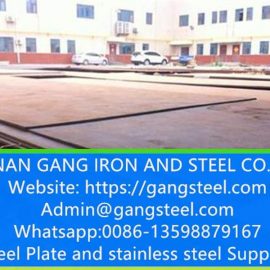asme sa516 grade 70 mechanical properties
SA516Gr.70 is widely used in petroleum, chemical, power station, boiler, and other industries used to make reactors, heat exchangers, separators, spherical tanks, gas tanks, liquefied gas tanks, nuclear reactor pressure shells, boiler drums, liquefied petroleum
Equipment and components such as gas cylinders, high-pressure water pipes of hydropower stations, and turbine volutes.
A516Gr70N meets the requirements of (ASME) ASTMA516/A516M standards, and fully meets the needs of oil gas with a high content of sulfur and hydrogen, reduces sulfur and hydrogen corrosion, reduces equipment maintenance, and increases equipment service life.
The steel plate has the following characteristics: good impact resistance, low-temperature deformation, good welding performance, good fatigue resistance, good anti-layer cracking performance, microalloying, high purity, low carbon equivalent, strong resistance to sulfur and hydrogen,
The products have good dimensional tolerances and surface quality.
We are ASME SA516 Gr.70 and ASME SA516GR.70 steel plate manufacturers,SA516GR.70 stocklist, SA516GR.70 cutting parts, SA 516 GR 70 machined parts supplier. Gangsteel exporter ASME SA516 Grade 70|ASME SA516GR.70 steel plate. SA516GR70 is a carbon pressure vessel steel grade. ASME SA516 GR.70 steel plates stock supplier.Keywords: ASME A516 Grade 70, ASME A516GR.70, ASME A516GR70, ASME A516 GR.70 SA516 Grade 70 steel is a carbon pressure vessel steel grade for moderate and lower temperature service.
SA516 Grade 70 usual request normalized if thickness above 40mm, if not, Gangsteel usual delivery in hot rolled or control rolled station. A516 Gr.70+N or A516gr70N mean that steel grade must be normalized in any thickness.

Resistance to corrosion and staining, low maintenance, and familiar luster make stainless-steel a super material for many purposes where each the power of steel and corrosion resistance are required. Moreover, stainless-steel could be rolled into sheets, plates, bars, wire, and tubing. Type S— is a highly alloyed austenitic stainless-steel used for top temperature utility. The excessive chromium and nickel content give the steel excellent oxidation resistance in addition to excessive strength at high temperature.
The corrosion resistance of iron-chromium alloys might have been first recognized in 1821 by Pierre Berthier, who noted their resistance in opposition to attack by some acids and advised their use in cutlery. The addition of nitrogen additionally improves resistance to pitting corrosion and will increase mechanical energy.
According to the International Resource Panel’s Metal Stocks in Society report, the per capita stock of stainless steel in use in society is 80–a hundred and eighty kg in additional developed international locations and 15 kg in much less-developed international locations. There is a secondary market that recycles usable scrap for many stainless-steel markets.
The tensile strength of SA516Gr70 is 70 kilopounds per square inch, which is more than 482 as everyone usually says.
The main element content is C Mn Si, and the control of p and s determines its performance.
There are very few other trace elements.
Standard Specification for Carbon Steel Plates for Medium and Low-Temperature Pressure Vessels
SA516Gr70 Chemical detail
C≤0.30��Mn��0.79-1.30��P≤0.035��S��≤0.035��Si��0.13-0.45
SA516Gr70 Property Grade U.S (SI), Tensile strength ksi(MPa) 70 (485) and 70-90 (485-620)
How many ASTM standards are there?
Today, over 12,000 ASTM standards are used around the world to improve product quality, enhance health and safety, strengthen market access and trade, and build consumer confidence.
- Type 304, the most common grade of stainless steel with 18% chromium, is immune to roughly 870 °C (1,600 °F).
- Resistance to different gases is dependent on the kind of gas, the temperature, and the alloying content material of the stainless steel.
- Other gases, such as sulfur dioxide, hydrogen sulfide, carbon monoxide, chlorine, additionally assault stainless-steel.
- The minimal 10.5% chromium in stainless steels offers resistance to approximately 700 °C (1,300 °F), while 16% chromium supplies resistance as much as roughly 1,200 °C (2,200 °F).
Austenitic stainless-steel is the largest household of stainless steels, making up about two-thirds of all stainless-steel production . They possess an austenitic microstructure, which is a face-centered cubic crystal construction. Thus, austenitic stainless steels usually are not hardenable by warmth therapy since they possess the same microstructure in any respect temperatures. Galvanic corrosion (additionally called “dissimilar-metallic corrosion”) refers to corrosion damage induced when two dissimilar materials are coupled in a corrosive electrolyte. The commonest electrolyte is water, ranging from freshwater to seawater.
ASME sa 516 gr 70 plate
To avoid corrosion in air, carbon steel is proscribed to roughly 480 °C (900 °F). Oxidation resistance in stainless steels increases with additions of chromium, silicon, and aluminium. Small additions of cerium and yttrium improve the adhesion of the oxide layer on the floor. Type 304 and Type 316 stainless steels are unaffected weak bases similar to ammonium hydroxide, even in high concentrations and at high temperatures. The similar grades uncovered to stronger bases similar to sodium hydroxide at high concentrations and high temperatures will likely experience some etching and cracking.
Heat treatment
1.·SA515Gr60, SA515Gr70, SA516Gr60, SA516Gr70, SA516Gr60N, SA516Gr70N thickness ≤1.5in, (40mm) steel plate is usually supplied in rolled state, steel plate can also be ordered by normalizing or stress relief, or normalizing plus stress relief.
2. Thickness>1.5in.(40mm) steel plate should be normalized.
3. Unless otherwise specified by the buyer, the thickness ≤ 1.5in, (40mm) steel plate, when notch toughness is required, normalizing should be carried out.
4. If approved by the buyer, it is allowed to use a cooling rate greater than that in the air to improve toughness, but the steel plate only needs to be in the range of 1100-1300°F (595-705°C) subsequently
asme sa516 grade 70n
Increasing chromium and nickel contents present elevated resistance. The invention of chrome steel followed a series of scientific developments, starting in 1798 when chromium was first proven sa516gr.70 steel supplier to the French Academy by Louis Vauquelin. In the early 1800s, James Stodart, Michael Faraday, and Robert Mallet noticed the resistance of chromium-iron alloys (“chromium steels”) to oxidizing agents.

